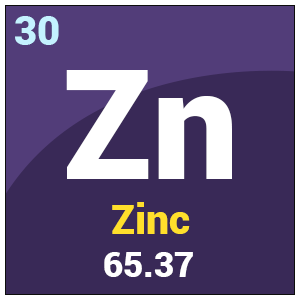Zinc: isotopes
Zinc isotopes are used extensively in both industrial and medical applications. Depleted Zn-64 is added to the cooling water of nuclear reactors in the form of oxide or acetate to prevent stress corrosion cracking. It also reduces the release of (stable) Co-59 into the cooling water by forming a thin spinel layer on the Co containing steel surfaces. Neutron irradiation of Co-59 will result in the formation of Co-60, a radioisotope which emits high energy gamma radiation and is a major contributor to the dose rate of personnel working in the reactor. Enriched Zn-67 is often used in biological research into the uptake of Zn in the human body. It can also be used for the production of radioactive Ga-67 in smaller cyclotrons. However, by far most Ga-67 is made from Zn-68. Zn-67, Zn-68 and Zn-70 can all be used for the production of the therapeutic isotope Cu-67. Zn-66 has been proposed as an alternative target for the production of Cu-64 and Ga-67. Finally Zn-70 is also used in biological research and in research into super-heavy elements.
Chemical properties of zinc - Health effects of zinc - Environmental effects of zinc
|
|
Zinc is a trace element that is essential for human health. When people absorb too little zinc they can experience a loss of appetite, decreased sense of taste and smell, slow wound healing and skin sores. Zinc-shortages can even cause birth defects. |
Effects of zinc on the Environment
The world's zinc production is still rising. This basically means that more and more zinc ends up in the environment. Water is polluted with zinc, due to the presence of large quantities of zinc in the wastewater of industrial plants. This wastewater is not purified satisfactory. One of the consequences is that rivers are depositing zinc-polluted sludge on their banks. Zinc may also increase the acidity of waters. Zinc cannot only be a threat to cattle, but also to plant species. Plants often have a zinc uptake that their systems cannot handle, due to the accumulation of zinc in soils. |
Read more on zinc in water
Back to the periodic table of elements.
More from 'Elements'
Zinc has the symbol Zn. Atomic Number = 30, Atomic Mass = 65.39, 30 protons, 30 electrons, 35 neutrons. Most common uses: The alloy brass contains copper and anywhere from 20-45% of zinc, depending upon the type of brass. Brass is easy to work and is a good electrical conductor. The Chemistry Division's Periodic Table describes the history, properties, resources, uses, isotopes, forms, costs, and other information for each element.
Lenntech (European Head Office)
Distributieweg 3
2645 EG Delfgauw
The Netherlands
Phone: +31 152 610 900
fax: +31 152 616 289
e-mail: info@lenntech.com
Lenntech USA LLC (Americas)
5975 Sunset Drive
South Miami, FL 33143
USA
Phone: +1 877 453 8095
e-mail: info@lenntech.com
Lenntech DMCC (Middle East)
Zn Atomic Number And Mass

Zn Ka Atomic Number

Level 5 - OFFICE #8-One JLT Tower
Jumeirah Lake Towers
Dubai - U.A.E.
Phone: +971 4 429 5853
e-mail: info@lenntech.com

Element Zn Atomic Number
Copyright © 1998-2021 Lenntech B.V. All rights reserved

